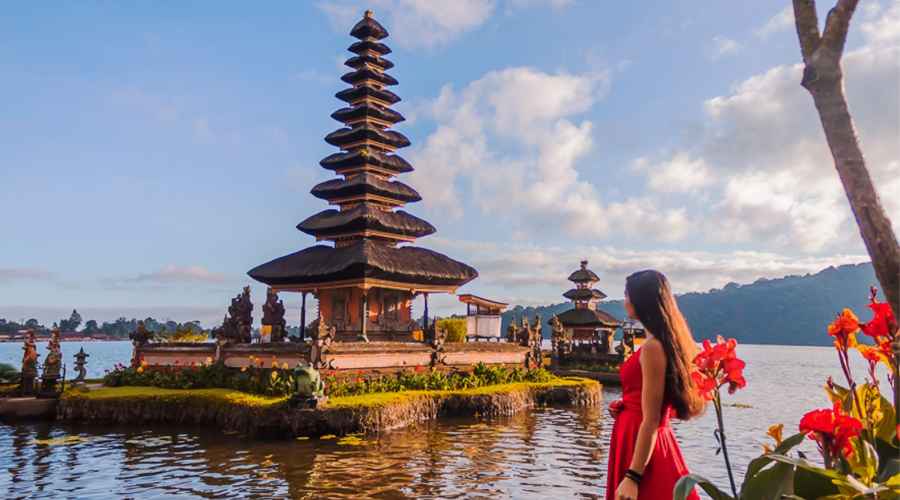Perched gracefully on the shores of Lake Beratan in the cool, misty highlands of Bedugul, Bali, Ulun Danu Beratan Temple stands as one of the most iconic and picturesque Hindu temples on the island. Often referred to simply as Ulun Danu Temple, it is revered not only for its stunning natural setting—seemingly floating on the lake—but also for its profound cultural and spiritual significance. Built in the 17th century, this temple complex serves as a center of worship for Dewi Danu, the Balinese goddess of water, lakes, and rivers, symbolizing the essential life-giving force of water in Bali’s agricultural and spiritual life.
Location and Setting
Ulun Danu Beratan Temple is located in the village of Candikuning, within the Bedugul area of Tabanan Regency, approximately 50 to 60 kilometers north of Denpasar, Bali’s capital. Situated about 1,200 meters above sea level, Bedugul is known for its cooler climate and lush mountainous landscapes, making it a refreshing contrast to Bali’s coastal heat. The temple adorns the edge of the serene Lake Beratan, with its tiered Meru towers and intricately carved pagodas seemingly floating on the reflective water’s surface, framed by mountains and frequent morning mist.
Historical Background
Constructed around 1633 AD by I Gusti Agung Putu, the king of the Mengwi Kingdom, Ulun Danu Beratan was conceived as a water temple to honor Dewi Danu, the goddess of lakes and rivers. Its foundation aimed at securing blessings for abundant water supply, essential for Bali’s rice fields and agriculture, particularly supporting the island’s intricate subak irrigation system. The temple complex also pays homage to the Hindu trinity of Brahma, Vishnu, and Shiva alongside Dewi Danu.
Archaeological evidence suggests that the site’s spiritual significance predates the temple’s 17th-century construction, with artifacts from Bali’s megalithic period found nearby, indicating long-standing sacred use of the location. The temple complex has undergone various restorations, including significant work in the 20th century, preserving its architectural elegance and religious role.
Architectural Features
Ulun Danu Beratan is renowned for its distinct Balinese architectural style, characterized by multi-tiered Meru towers with thatched roofs resembling pagodas. The temple complex includes several smaller temples, each with specific spiritual roles:
- Pura Penataran Agung: The main temple used for large ceremonial rites.
- Pura Dalem Purwa: Dedicated to deities associated with the afterlife and spiritual realms.
- Pura Lingga Petak: Situated on its own small island, it is the most photographed part of the complex with its serene lake backdrop.
- Pura Teratai Bang: Commonly used for purification ceremonies called Melasti.
The distinct placement of these shrines, surrounded by water on three sides, enhances the temple’s mystical ambiance. Visitors often marvel at the temple’s “floating” illusion during high water levels, a feature made iconic on Indonesian currency and widely featured in photographs representing Bali.
Cultural and Spiritual Importance
Ulun Danu Beratan Temple holds immense spiritual significance for Balinese Hindus. It is a major site for offerings and prayers dedicated to Dewi Danu, who embodies the nourishing waters essential to Bali’s rice terraces and daily life. The temple is also a focal point for rituals intending to maintain harmony between humans, nature, and the divine forces governing water and fertility, deeply entrenched in Bali’s agrarian culture.
The temple is considered part of the Balinese concept of Rwa Bhineda, reflecting a universal balance of opposing forces—Ulun Danu symbolizing the feminine energy complementing the masculine force represented by Bali’s Besakih Temple. This balance underscores the temple’s role not just in spirituality but also in symbolizing prosperity and well-being among Balinese communities.
Visiting Ulun Danu Beratan
Visiting Ulun Danu Beratan is a sensory experience. The crisp mountain air, panoramic views of the lake, and serene temple grounds transport visitors into a sacred realm of peace. Many tourists come early in the morning to experience the mist-shrouded waters and capture stunning reflections of the temple on the lake’s surface.
Visitors can walk around the temple grounds, admire intricate stone carvings, and shop for local crafts nearby. While bathing in the lake is prohibited due to its sacred status, the temple’s surroundings provide excellent spots for photography and quiet contemplation. Nearby gardens and traditional markets add to the visitor experience, offering insight into local culture.
Best Time to Visit and Travel Tips
The best time to visit Ulun Danu Beratan is during Bali’s dry season, from April to October, when the weather is clear and the lake’s waters provide optimal conditions for viewing the temple’s reflection. The highland location means temperatures can be cooler, so dressing in layers is advisable.
Travelers should respect temple customs such as wearing a sarong and sash, which are often provided at the entrance, and maintain quiet reverence on site. Early mornings or late afternoons provide the most tranquil atmosphere and best light for photography.
Nearby Attractions
Ulun Danu Beratan serves as a gateway for exploring the Bedugul region, known for its botanical gardens, strawberry farms, and the iconic Handara Golf & Resort with its famous Bali Gate. The highlands also offer hiking opportunities and other temples to discover, making it a perfect day trip from areas like Ubud or southern Bali.
Conclusion
Ulun Danu Beratan Temple is much more than a beautiful tourist spot. It is a living symbol of Bali’s harmonious relationship with nature, water, and spirituality. With its majestic lakeside setting, historical depth, and cultural richness, it remains a beloved shrine and a must-visit highlight for those seeking to experience the spirituality and natural splendor that Bali uniquely offers.


